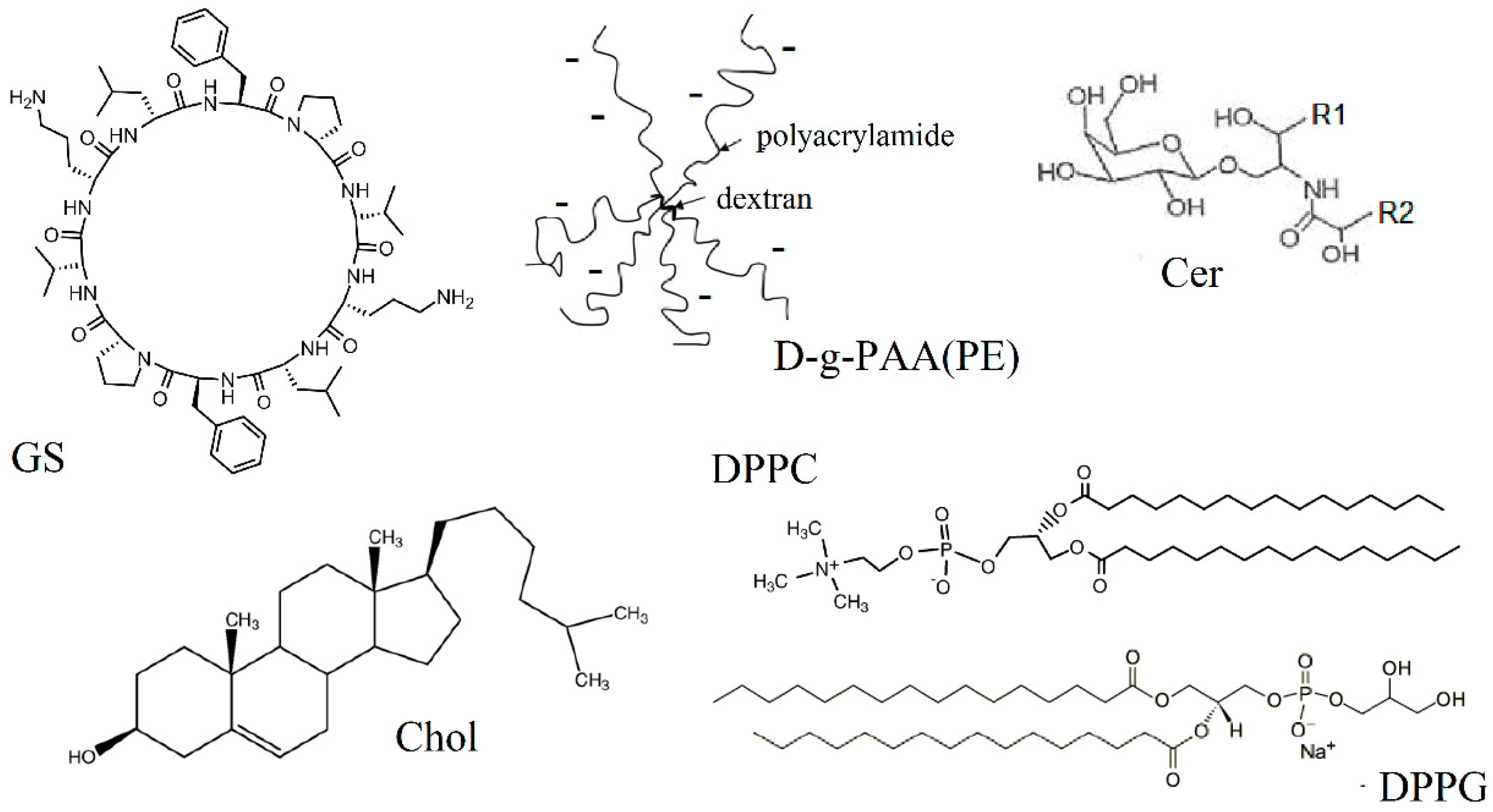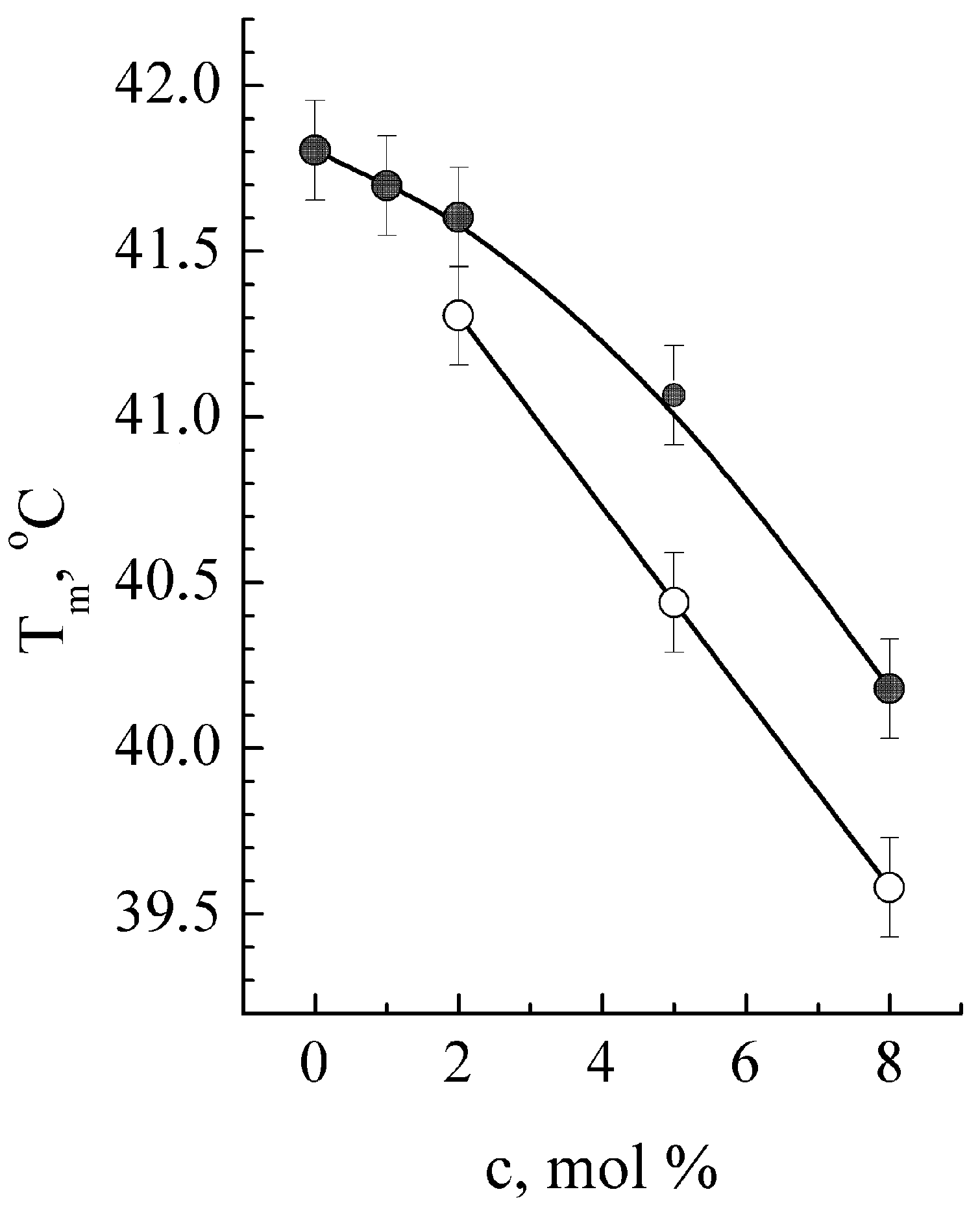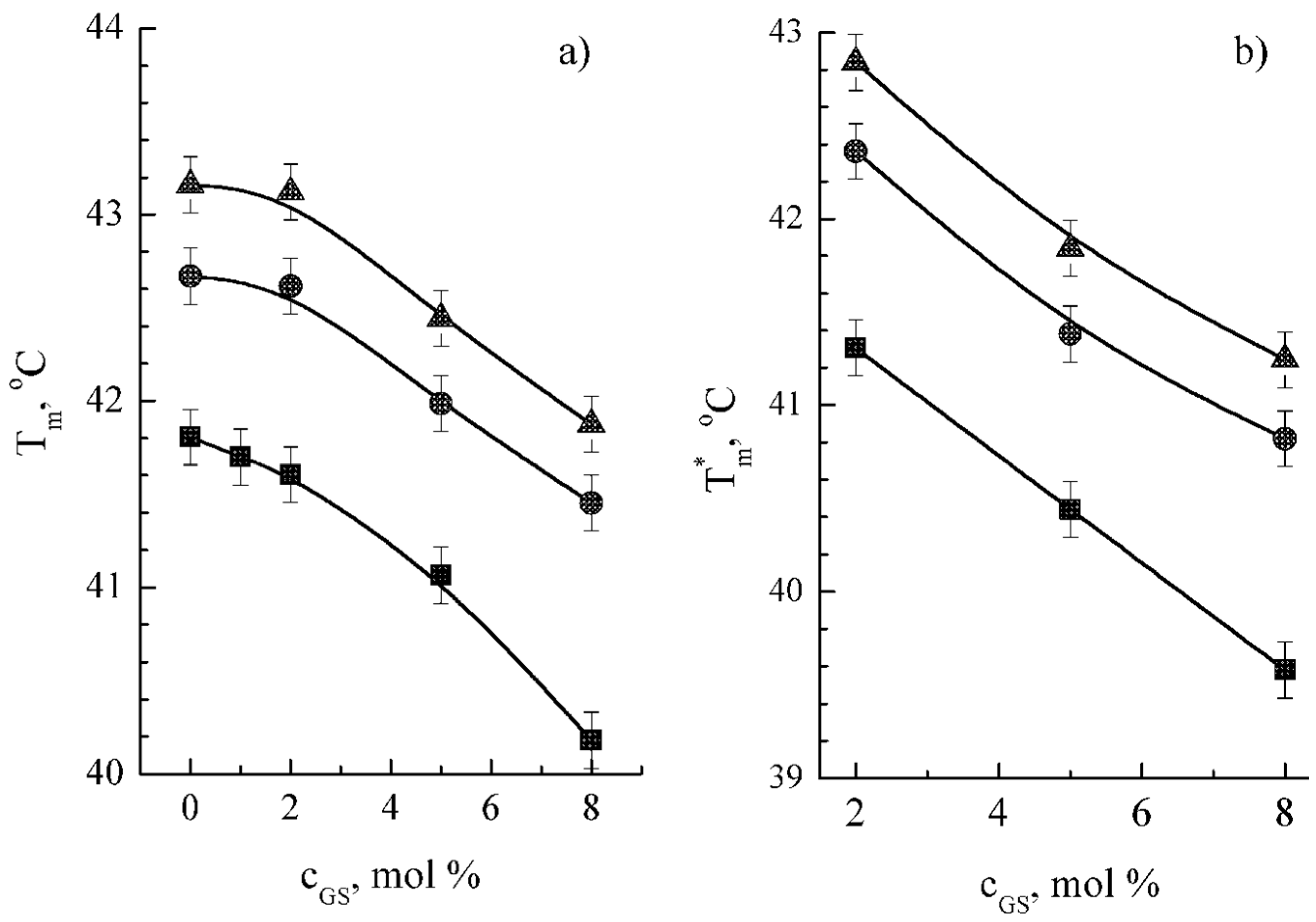Modifying Membranotropic Action of Antimicrobial Peptide Gramicidin S by Star-like Polyacrylamide and Lipid Composition of Nanocontainers
Abstract
:1. Introduction
2. Results
2.1. Impact of Cholesterol Content
2.2. Impact of Lipid Composition
2.3. Impact of a Polymer Carrier
2.4. Impact of Calcium Ions
3. Discussion
4. Materials and Methods
4.1. Membrane Preparation
4.2. DSC Investigations
4.3. FTIR Investigations
4.4. Statistical Analysis
4.5. Data Sharing Statement
5. Conclusions
Author Contributions
Funding
Institutional Review Board Statement
Informed Consent Statement
Data Availability Statement
Conflicts of Interest
References
- Chiu, M.H.; Prenner, E.J. Differential scanning calorimetry: An invaluable tool for a detailed thermodynamic characterization of macromolecules and their interactions. J. Pharm. Bioallied. Sci. 2011, 3, 39–59. [Google Scholar] [CrossRef] [PubMed] [PubMed Central]
- Babii, O.; Afonin, S.; Ishchenko, A.Y.; Schober, T.; Negelia, A.O.; Tolstanova, G.M.; Garmanchuk, L.V.; Ostapchenko, L.I.; Komarov, I.V.; Ulrich, A.S. Structure-Activity Relationships of Photoswitchable Diarylethene-Based β-Hairpin Peptides as Membranolytic Antimicrobial and Anticancer Agents. J. Med. Chem. 2018, 61, 10793–10813. [Google Scholar] [CrossRef] [PubMed]
- Prenner, E.J.; Lewis, R.N.; Kondejewski, L.H.; Hodges, R.S.; McElhaney, R.N. Differential scanning calorimetric study of the effect of the antimicrobial peptide gramicidin S on the thermotropic phase behavior of phosphatidylcholine, phosphatidylethanolamine and phosphatidylglycerol lipid bilayer membranes. Biochim. Biophys. Acta 1999, 1417, 211–223. [Google Scholar] [CrossRef] [PubMed]
- Toyran, N.; Severcan, F. Infrared Spectroscopic Studies on the Dipalmitoyl Phosphatidylcholine Bilayer Interactions with Calcium Phosphate: Effect of Vitamin D2. J. Spectrosc. 2002, 16, 381692. [Google Scholar] [CrossRef]
- Grage, S.L.; Afonin, S.; Kara, S.; Buth, G.; Ulrich, A.S. Membrane Thinning and Thickening Induced by Membrane-Active Amphipathic Peptides. Front. Cell Dev. Biol. 2016, 4, 65. [Google Scholar] [CrossRef] [PubMed] [PubMed Central]
- Swierstra, J.; Kapoerchan, V.; Knijnenburg, A.; van Belkum, A.; Overhand, M. Structure, toxicity and antibiotic activity of gramicidin S and derivatives. Eur. J. Clin. Microbiol. Infect. Dis. 2016, 35, 763–769. [Google Scholar] [CrossRef] [PubMed] [PubMed Central]
- Krivanek, R.; Rybar, P.; Prenner, E.J.; McElhaney, R.N.; Hianik, T. Interaction of the antimicrobial peptide gramicidin S with dimyristoyl—Phosphatidylcholine bilayer membranes: A densitometry and sound velocimetry study. Biochim. Biophys. Acta 2001, 1510, 452–463. [Google Scholar] [CrossRef] [PubMed]
- Onda, M.; Hayashi, H.; Mita, T. Interaction of gramicidin with lysophosphatidylcholine as revealed by calorimetry and fluorescence spectroscopy. J. Biochem. 2001, 130, 613–620. [Google Scholar] [CrossRef] [PubMed]
- Abraham, T.; Prenner, E.J.; Lewis, R.N.; Mant, C.T.; Keller, S.; Hodges, R.S.; McElhaney, R.N. Structure-activity relationships of the antimicrobial peptide gramicidin S and its analogs: Aqueous solubility, self-association, conformation, antimicrobial activity and interaction with model lipid membranes. Biochim. Biophys. Acta 2014, 1838, 1420–1429. [Google Scholar] [CrossRef] [PubMed]
- Afonin, S.; Glaser, R.W.; Sachse, C.; Salgado, J.; Wadhwani, P.; Ulrich, A.S. (19)F NMR screening of unrelated antimicrobial peptides shows that membrane interactions are largely governed by lipids. Biochim. Biophys. Acta 2014, 1838, 2260–2268. [Google Scholar] [CrossRef] [PubMed]
- Berditsch, M.; Lux, H.; Babii, O.; Afonin, S.; Ulrich, A.S. Therapeutic Potential of Gramicidin S in the Treatment of Root Canal Infections. Pharmaceuticals 2016, 9, 56. [Google Scholar] [CrossRef] [PubMed] [PubMed Central]
- Kapoerchan, V.V.; Knijnenburg, A.D.; Keizer, P.; Spalburg, E.; de Neeling, A.J.; Mars-Groenendijk, R.H.; Noort, D.; Otero, J.M.; Llamas-Saiz, A.L.; van Raaij, M.J.; et al. ‘Inverted’ analogs of the antibiotic gramicidin S with an improved biological profile. Bioorg. Med. Chem. 2012, 20, 6059–6062. [Google Scholar] [CrossRef] [PubMed]
- Reißer, S.; Strandberg, E.; Steinbrecher, T.; Ulrich, A.S. 3D hydrophobic moment vectors as a tool to characterize the surface polarity of amphiphilic peptides. Biophys. J. 2014, 106, 2385–2394. [Google Scholar] [CrossRef] [PubMed] [PubMed Central]
- Jakubke, H.-D.; Jeschkeit, H. Aminosauren, Peptide, Proteine; Publisher Akademie-Verlag: Berlin, Germany, 1981; ISBN 9783112702147. [Google Scholar]
- Lohner, K.; Blondelle, S.E. Molecular mechanisms of membrane perturbation by antimicrobial peptides and the use of biophysical studies in the design of novel peptide antibiotics. Comb. Chem. High Throughput Screen. 2005, 8, 241–256. [Google Scholar] [CrossRef] [PubMed]
- Wenzel, M.; Rautenbach, M.; Vosloo, J.A.; Siersma, T.; Aisenbrey, C.H.M.; Zaitseva, E.; Laubscher, W.E.; van Rensburg, W.; Behrends, J.C.; Bechinger, B.; et al. The Multifaceted Antibacterial Mechanisms of the Pioneering Peptide Antibiotics Tyrocidine and Gramicidin S. mBio 2018, 9, e00802-18. [Google Scholar] [CrossRef] [PubMed] [PubMed Central]
- Kalyvas, J.T.; Wang, Y.; Toronjo-Urquiza, L.; Stachura, D.L.; Yu, J.; Horsley, J.R.; Abell, A.D. A New Gramicidin S Analogue with Potent Antibacterial Activity and Negligible Hemolytic Toxicity. J. Med. Chem. 2024; epub ahead of print. [Google Scholar] [CrossRef] [PubMed]
- Ashrafuzzaman, M. The Antimicrobial Peptide Gramicidin S Enhances Membrane Adsorption and Ion Pore Formation Potency of Chemotherapy Drugs in Lipid Bilayers. Membranes 2021, 11, 247. [Google Scholar] [CrossRef] [PubMed] [PubMed Central]
- Koynova, R.; Tenchov, B. Transitions between lamellar and nonlamellar phases in membrane lipids and their physiological roles. OA Biochem. 2013, 1, 9. [Google Scholar] [CrossRef]
- Delcour, A.H. Outer membrane permeability and antibiotic resistance. Biochim. Biophys. Acta 2009, 1794, 808–816. [Google Scholar] [CrossRef] [PubMed] [PubMed Central]
- Matsuzaki, K. Control of cell selectivity of antimicrobial peptides. Biochim. Biophys. Acta 2009, 1788, 1687–1692. [Google Scholar] [CrossRef] [PubMed]
- Berest, V.P.; Sotnikov, A.; Sichevska, L.V. Lipid Nanocarriers Impede Side Effects of Delivered Antimicrobial Peptide. In Proceedings of the IEEE 3rd Ukraine Conference on Electrical and Computer Engineering (UKRCON), Lviv, Ukraine, 26–28 August 2021; pp. 513–518. [Google Scholar] [CrossRef]
- Hackl, E.V.; Berest, V.P.; Gatash, S.V. Effect of Cholesterol Content on Gramicidin S-Induced Hemolysis of Erythrocytes. Int. J. Pept. Res. Ther. 2012, 18, 163–170. [Google Scholar] [CrossRef]
- Mannock, D.A.; Lewis, R.N.; McMullen, T.P.; McElhaney, R.N. The effect of variations in phospholipid and sterol structure on the nature of lipid-sterol interactions in lipid bilayer model membranes. Chem. Phys. Lipids 2010, 163, 403–448. [Google Scholar] [CrossRef] [PubMed]
- Carey, A.B.; Ashenden, A.; Köper, I. Model architectures for bacterial membranes. Biophys. Rev. 2022, 14, 111–143. [Google Scholar] [CrossRef] [PubMed] [PubMed Central]
- Merrill, A.H. Sphingolipids. In Biochemistry of Lipids, Lipoproteins and Membranes, 5th ed.; Vance, D.E., Vance, J., Eds.; Elsevier: Amsterdam, The Netherlands, 2008; pp. 363–397. [Google Scholar]
- Bouwstra, J.A.; Dubbelaar, F.E.; Gooris, G.S.; Ponec, M. The lipid organisation in the skin barrier. Acta Derm.-Venereol. 2000, 208, 23–30. [Google Scholar] [CrossRef] [PubMed]
- Rautenbach, M.; Eyéghé-Bickong, H.A.; Vlok, N.M.; Stander, M.; de Beer, A. Direct surfactin-gramicidin S antagonism supports detoxification in mixed producer cultures of Bacillus subtilis and Aneurinibacillus migulanus. Microbiology 2012, 158 Pt 12, 3072–3082. [Google Scholar] [CrossRef] [PubMed]
- Telegeev, G.; Kutsevol, N.; Chumachenko, V.; Naumenko, A.; Telegeeva, P.; Filipchenko, S.; Harahuts, Y. Dextran-Polyacrylamide as Matrices for Creation of Anticancer Nanocomposite. Int. J. Polym. Sci. 2017, 2017, 4929857. [Google Scholar] [CrossRef]
- Merlitz, H.; Wu, C.-X.; Sommer, J.-U. Starlike Polymer Brushes. Macromolecules 2011, 44, 7043–7049. [Google Scholar] [CrossRef]
- Kutsevol, N.V.; Chumachenko, V.A.; Rawiso, M.; Shkodich, V.F.; Stoyanov, O.V. Star-like dextran-polyacrylamide polymers: Prospects of use in nanotechnologies. J. Struct. Chem. 2015, 56, 959–966. [Google Scholar] [CrossRef]
- Chumachenko, V.; Virych, P.; Nie, G.; Virych, P.; Yeshchenko, O.; Khort, P.; Tkachenko, A.; Prokopiuk, V.; Lukianova, N.; Zadvornyi, T.; et al. Combined Dextran-Graft-Polyacrylamide/Zinc Oxide Nanocarrier for Effective Anticancer Therapy in vitro. Int. J. Nanomed. 2023, 18, 4821–4838. [Google Scholar] [CrossRef]
- Kutsevol, N.; Harahuts Yu Chumachenko, V.; Budianska, L.V.; Vashchenko, O.V.; Kasian, N.A.; Lisetski, L.N. Impact of surface properties of branched polyacrylamides onto model lipid membranes of various compositions. Mol. Cryst. Liq. Cryst. 2018, 671, 9–16. [Google Scholar] [CrossRef]
- Hackl, E.V.; Berest, V.P.; Gatash, S.V. Interaction of polypeptide antibiotic gramicidin S with platelets. J. Pept. Sci. 2012, 18, 748–754. [Google Scholar] [CrossRef] [PubMed]
- Parkhomenko, I.M.; Zarubina, A.P.; Romanova, N.A.; Kossova, G.V. Radiobiologicheskie osobennosti P+-varianta Bacillus brevis var. G.—B.v sviazi s sintezom gramitsidina S [The radiobiological characteristics of the P+ variant of Bacillus brevis var. G.—B. in relation to gramicidin S synthesis]. Nauchnye Dokl. Vyss. Shkoly Biol. Nauk. 1990; 48–55. (In Russian) [Google Scholar] [PubMed]
- Johnke, R.M.; Sattler, J.A.; Allison, R.R. Radioprotective agents for radiation therapy: Future trends. Future Oncol. 2014, 10, 2345–2357. [Google Scholar] [CrossRef] [PubMed]
- Brodskii, R.Y.; Vashchenko, O.V. Mutual impact of alternative mechanisms of a dopant embedding into an ordered medium: A case of gramicidin S in model lipid membranes. Funct. Mater. 2023, 30, 413–423. [Google Scholar] [CrossRef]
- Lisetski, L.N.; Vashchenko, O.V.; Kasian, N.A.; Krasnikova, A.O. Liquid crystal ordering and nanostructuring in model lipid membranes. In Nanobiophysics: Fundamentals and Applications; Karachevtsev, V.A., Ed.; Pan Stanford Publishing: Singapore, 2016; pp. 163–192, ISBN 978-981-4613-96-5 (Hardcover)/978-981-4613-97-2 (eBook). [Google Scholar]
- Diakowski, W.; Ozimek, Ł.; Bielska, E.; Bem, S.; Langner, M.; Sikorski, A.F. Cholesterol affects spectrin-phospholipid interactions in a manner different from changes resulting from alterations in membrane fluidity due to fatty acyl chain composition. Biochim. Biophys. Acta 2006, 1758, 4–12. [Google Scholar] [CrossRef] [PubMed]
- Subczynski, W.K.; Pasenkiewicz-Gierula, M.; Widomska, J.; Mainali, L.; Raguz, M. High Cholesterol/Low Cholesterol: Effects in Biological Membranes: A Review. Cell Biochem. Biophys. 2017, 75, 369–385. [Google Scholar] [CrossRef] [PubMed] [PubMed Central]
- Miller, I.R.; Bach, D.; Wachtel, E.J.; Eisenstein, M. Interrelation between hydration and interheadgroup interaction in phospholipids. Bioelectrochemistry 2002, 58, 193–196. [Google Scholar] [CrossRef] [PubMed]
- Bensikaddour, H.; Snoussi, K.; Lins, L.; Van Bambeke, F.; Tulkens, P.M.; Brasseur, R.; Goormaghtigh, E.; Mingeot-Leclercq, M.P. Interactions of ciprofloxacin with DPPC and DPPG: Fluorescence anisotropy, ATR-FTIR and 31P NMR spectroscopies and conformational analysis. Biochim. Biophys. Acta 2008, 1778, 2535–2543. [Google Scholar] [CrossRef] [PubMed]
- Pawlikowska-Pawlęga, B.; Dziubińska, H.; Król, E.; Trębacz, K.; Jarosz-Wilkołazka, A.; Paduch, R.; Gawron, A.; Gruszecki, W.I. Characteristics of quercetin interactions with liposomal and vacuolar membranes. Biochim. Biophys. Acta 2014, 1838 Pt B, 254–265. [Google Scholar] [CrossRef] [PubMed]
- Carrillo, C.; Teruel, J.A.; Aranda, F.J.; Ortiz, A. Molecular mechanism of membrane permeabilization by the peptide antibiotic surfactin. Biochim. Biophys. Acta 2003, 1611, 91–97. [Google Scholar] [CrossRef] [PubMed]
- Joshi, K.; Semrouni, D.; Ohanessian, G.; Clavaguéra, C. Structures and IR spectra of the Gramicidin S peptide: Pushing the quest for low-energy conformations. J. Phys. Chem. B 2012, 116, 483–490. [Google Scholar] [CrossRef] [PubMed]
- Binder, H. Water near lipid membranes as seen by infrared spectroscopy. Eur. Biophys. J. 2007, 36, 265–279. [Google Scholar] [CrossRef] [PubMed]
- Arias, J.M.; Tuttolomondo, M.E.; Díaz, S.B.; Ben Altabef, A. Reorganization of Hydration Water of DPPC Multilamellar Vesicles Induced by l-Cysteine Interaction. J. Phys. Chem. B 2018, 122, 5193–5204. [Google Scholar] [CrossRef] [PubMed]
- Jelokhani-Niaraki, M.; Hodges, R.S.; Meissner, J.E.; Hassenstein, U.E.; Wheaton, L. Interaction of gramicidin S and its aromatic amino-acid analog with phospholipid membranes. Biophys. J. 2008, 95, 3306–3321. [Google Scholar] [CrossRef] [PubMed] [PubMed Central]
- Mannock, D.A.; Lewis, R.N.; McElhaney, R.N. A calorimetric and spectroscopic comparison of the effects of ergosterol and cholesterol on the thermotropic phase behavior and organization of dipalmitoylphosphatidylcholine bilayer membranes. Biochim. Biophys. Acta 2010, 1798, 376–388. [Google Scholar] [CrossRef] [PubMed]
- Popova, A.V.; Hincha, D.K. Effects of cholesterol on dry bilayers: Interactions between phosphatidylcholine unsaturation and glycolipid or free sugar. Biophys. J. 2007, 93, 1204–1214. [Google Scholar] [CrossRef] [PubMed] [PubMed Central]
- Ho, C.; Slater, S.J.; Stubbs, C.D. Hydration and order in lipid bilayers. Biochemistry 1995, 34, 6188–6195. [Google Scholar] [CrossRef] [PubMed]
- Kutsevol, N.; Bezuglyi, M.; Bezugla, T.; Rawiso, M. Star-Like Dextran-graft-(polyacrylamide-co-polyacrylic acid) Copolymers. Macromol. Symp. 2014, 335, 12–16. [Google Scholar] [CrossRef]
- Shimokawa, N.; Hishida, M.; Seto, H.; Yoshikawa, K. Phase separation of a mixture of charged and neutral lipids on a giant vesicle induced by small cations. Chem. Phys. Lett. 2010, 496, 59–63. [Google Scholar] [CrossRef]
- Zander, T.; Garamus, V.M.; Dédinaité, A.; Claesson, P.M.; Bełdowski, P.; Górny, K.; Dendzik, Z.; Wieland, D.C.F.; Willumeit-Römer, R. Influence of the Molecular Weight and the Presence of Calcium Ions on the Molecular Interaction of Hyaluronan and DPPC. Molecules 2020, 25, 3907. [Google Scholar] [CrossRef]
- Vashchenko, O.V.; Kasian, N.A.; Budianska, L.V.; Brodskii, R.Y.; Bespalova, I.I.; Lisetski, L.N. Adsorption of ions on model phospholipid membranes. J. Mol. Liq. 2019, 275, 173–177. [Google Scholar] [CrossRef]
- Vashchenko, O.V.; Ermak, I.u.L.; Lisetskiĭ, L.N. Univalent ions in phospholipid model membranes: Thermodynamic and hydration aspects. Biofizika 2013, 58, 663–673. (In Russian) [Google Scholar] [CrossRef] [PubMed]
- Raudino, A.; Sarpietro, M.G.; Pannuzzo, M. The thermodynamics of simple biomembrane mimetic systems. J. Pharm. Bioallied. Sci. 2011, 3, 15–38. [Google Scholar] [CrossRef] [PubMed] [PubMed Central]
- Le, M.T.; Litzenberger, J.K.; Prenner, E.J. Biomimetic Model Membrane Systems Serve as Increasingly Valuable in Vitro Tools. In Advances in Biomimetics; Cavrak, M., Ed.; IntechOpen: Rijeka, Croatia, 2011; pp. 251–276. ISBN 978-953-307-191-6. Available online: http://www.intechopen.com/books/advances-inbiomimetics/biomimetic-model-membrane-systems-serve-as-increasingly-valuable-in-vitro-tools (accessed on 3 August 2024). [CrossRef]





| No. | Lipid Composition | amol, °C | ΔTm1/2, °C | ΔΔHm1/2, kJ/mol |
|---|---|---|---|---|
| 1 | DPPC | −0.3 | 1.9 | −12 |
| 2 | DPPC-DPPG | −0.2 | 2.2 | −14 |
| 3 | DPPC-Cer | −0.2 | 2.1 | −15 |
| 4 | DPPC-Chol | −1.5 * | 11.2 * | −17 |
| Functional Group | Methylene | Carbonyl | Phosphate | |
|---|---|---|---|---|
| Membrane | ||||
| DPPC-DPPG | half-width νasCH2 ↑ δCH2 ↑ | minor changes | hydration ↓ | |
| DPPC-Cer | half-width νCH2 ↓ δCH2 ↑ | minor changes | minor changes | |
| DPPC-Chol | half-width νCH2 ↓ δCH2 ↓ | hydration ↑ hypsochromic shift | hydration ↓ (compensation of Chol effect) | |
Disclaimer/Publisher’s Note: The statements, opinions and data contained in all publications are solely those of the individual author(s) and contributor(s) and not of MDPI and/or the editor(s). MDPI and/or the editor(s) disclaim responsibility for any injury to people or property resulting from any ideas, methods, instructions or products referred to in the content. |
© 2024 by the authors. Licensee MDPI, Basel, Switzerland. This article is an open access article distributed under the terms and conditions of the Creative Commons Attribution (CC BY) license (https://creativecommons.org/licenses/by/4.0/).
Share and Cite
Vashchenko, O.V.; Berest, V.P.; Sviechnikova, L.V.; Kutsevol, N.V.; Kasian, N.A.; Sofronov, D.S.; Skorokhod, O. Modifying Membranotropic Action of Antimicrobial Peptide Gramicidin S by Star-like Polyacrylamide and Lipid Composition of Nanocontainers. Int. J. Mol. Sci. 2024, 25, 8691. https://doi.org/10.3390/ijms25168691
Vashchenko OV, Berest VP, Sviechnikova LV, Kutsevol NV, Kasian NA, Sofronov DS, Skorokhod O. Modifying Membranotropic Action of Antimicrobial Peptide Gramicidin S by Star-like Polyacrylamide and Lipid Composition of Nanocontainers. International Journal of Molecular Sciences. 2024; 25(16):8691. https://doi.org/10.3390/ijms25168691
Chicago/Turabian StyleVashchenko, Olga V., Volodymyr P. Berest, Liliia V. Sviechnikova, Nataliya V. Kutsevol, Natalia A. Kasian, Dmitry S. Sofronov, and Oleksii Skorokhod. 2024. "Modifying Membranotropic Action of Antimicrobial Peptide Gramicidin S by Star-like Polyacrylamide and Lipid Composition of Nanocontainers" International Journal of Molecular Sciences 25, no. 16: 8691. https://doi.org/10.3390/ijms25168691






